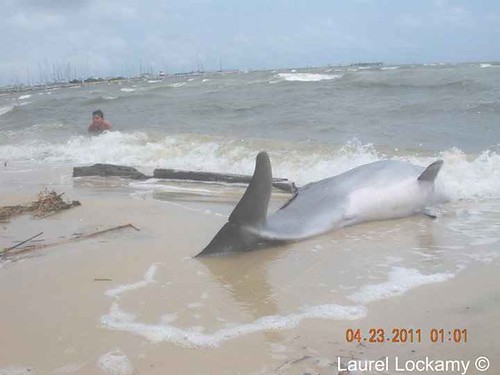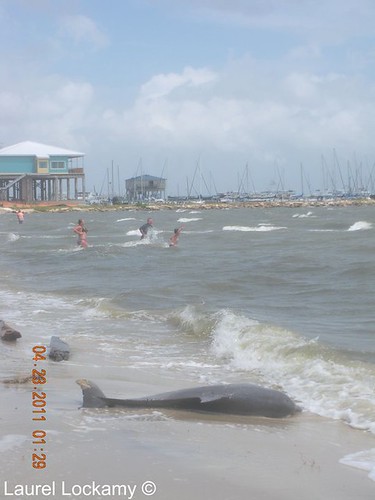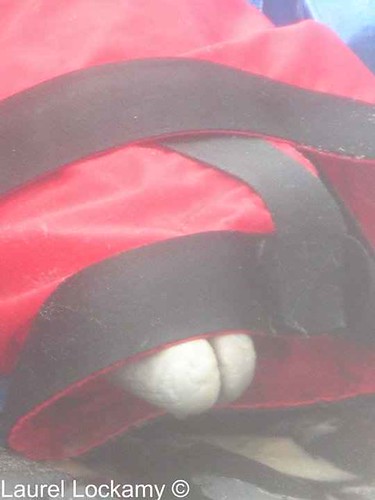More Than a Year Later, Gulf Dolphins and Turtles Keep Dying
The anniversary of the country’s worst oil disaster came and went last week. There was a brief frenzy of media attention, a litany of speeches and promises by politicians, and emotional memorials in honor of the 11 men who died in the Deepwater Horizon’s fiery explosion a year ago.
But for many in the Gulf struggling to regain their livelihoods, life is far from normal, the future far from certain. Even though one-year anniversaries are great for bringing people together to share their stories, their grieving and their hopes, it hasn’t stopped the dying.
Just ask Laurel Lockamy. The Gulfport, MS, resident wants to forget the painful year she experienced watching her ocean beaches tainted by oil, followed by a wave of countless carcasses of turtles, dolphins, sea birds and sealife of all kinds. But she can't escape it.
Last weekend, Laurel was lounging in her pajamas, checking her Facebook account. “Dead Dolphin!” a friend emailed her. She had been out checking the beaches on the way to a community oil protest in Grand Isle, LA. There on the Mississippi beach, she found a fully grown dolphin lay in the sand not far from Long Beach harbor. Across the street was a BP gas station.


Long Beach, MS All photos by Laurel Lockamy
Laurel describes her reaction this way:
At first I told her I could not...see it. I was just so depressed about all of the dead stuff I had planned on staying home and not going to the beach..but the more I thought about it I PUT ON CLOTHES AND JUMPED IN THE CAR WITH MY CAMERA AND HEADED THAT WAY!!
When she arrived the dolphin was still there, its silvery body still fresh, its bottle nose turned toward its salt water home. Tourists splashed in the water. A young boy surfed the waves nearby, seemingly oblivious to the lifeless marine mammal lying in the sand. Families were frolicking in the sea an hour later when a crew from the Institute for Marine Mammal Studies showed up to take the animal away for testing. The deceased dolphin is now potential evidence for a federal criminal investigation of the BP oil blowout.
Laurel watched as the workers took out a red canvass body bag, flipped the dolphin on its side and slowly pushed it onto the mobile stretcher by the water's edge. It took four people to lift up the carcass and cart it to their truck, where they wrapped it up tightly. Only the dolphin’s signature bottle nose peeked out, the only clue as to what was inside.


Federal officials have now tallied at least 77 bottlenose dolphin deaths this year from the Texas-Louisiana border to Franklin County, FL, more than five times average. Researchers estimate that 50 times that number may actually have died. Turtles continue to die in high numbers as well. So far this year, at least 250 dead endangered sea turtles have washed up on the Alabama, Mississippi and Louisiana coastline. Laurel has photographed many of them. It’s not been easy to do. But she says this dolphin hurt the most.
When I came home and saw my own photos I CRIED FOR THE VERY FIRST TIME SINCE I HAVE STARTED DOING THIS!! :( My own photos made me cry!!!
Federal officials say they do not know what is causing the unusual dolphin and turtle die-offs along the Gulf coast. They continue to investigate many potential causes, including the oil spill. No one knows when they may come up with an answer, if ever.
That doesn’t stop Laurel and other Gulf coast residents from looking for themselves. They are part of a growing network of citizens keeping watch on their beaches and marshlands, carefully documenting what they believe are the tragic consequences of the BP oil disaster. They complain the local media ignores the dead dolphins and endangered sea turtles that wash up on their shores. They blame BP’s massive ad campaigns and local economic and political interests for keeping people in the dark. Meanwhile, a year later, Congress has done nothing to fix the problems that caused this disaster in the first place.
Laurel and her friends say they wish the oil were gone. But it’s not. Along with dead turtles and dolphins, tar balls wash onto the Gulf shores every day. Until it stops, they say they will be there walking the beaches, cameras in hand, documenting whatever they see.
They know their cameras don’t lie.
